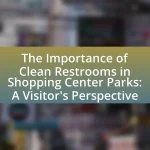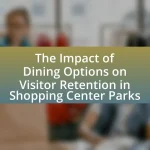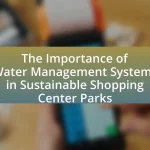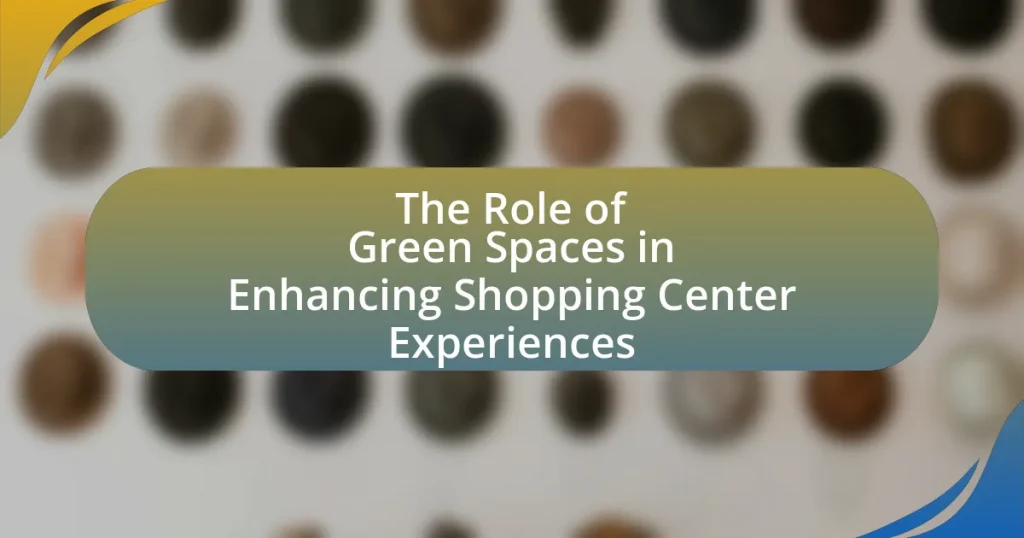The article examines the significant role of green spaces in enhancing shopping center experiences. It highlights how greenery contributes to customer satisfaction by providing a relaxing environment that reduces stress and encourages longer visits. Research indicates that shopping centers with green spaces see increased foot traffic and spending, as these areas foster community engagement and improve overall shopping experiences. The article also discusses various types of green spaces, their psychological effects on shoppers, and best practices for integrating and maintaining these areas to maximize their benefits.

What is the role of green spaces in enhancing shopping center experiences?
Green spaces play a crucial role in enhancing shopping center experiences by providing a relaxing environment that encourages longer visits and increased customer satisfaction. Research indicates that the presence of greenery can reduce stress and improve mood, leading to a more enjoyable shopping experience. For instance, a study published in the Journal of Environmental Psychology found that shoppers in areas with natural elements reported higher levels of satisfaction and were more likely to return. Additionally, green spaces can serve as social hubs, fostering community interaction and engagement, which further enriches the overall shopping experience.
How do green spaces contribute to the overall shopping experience?
Green spaces enhance the overall shopping experience by providing a calming environment that encourages longer visits and increased customer satisfaction. Studies show that shoppers are more likely to spend time and money in areas with greenery, as natural elements reduce stress and improve mood. For instance, research published in the Journal of Environmental Psychology indicates that exposure to green spaces can lead to a 20% increase in time spent shopping. Additionally, green spaces can attract more foot traffic, as they create a more inviting atmosphere, ultimately benefiting retailers through higher sales.
What psychological effects do green spaces have on shoppers?
Green spaces positively influence shoppers by reducing stress and enhancing mood. Research indicates that exposure to greenery can lower cortisol levels, which are associated with stress, and promote feelings of relaxation and well-being. A study published in the Journal of Environmental Psychology found that shoppers in environments with natural elements reported higher satisfaction and a greater likelihood of returning to the shopping center. Additionally, green spaces can encourage longer visits, as shoppers tend to feel more comfortable and engaged in aesthetically pleasing environments.
How do green spaces influence shopper behavior and spending?
Green spaces positively influence shopper behavior and spending by creating a more inviting and relaxing environment. Research indicates that shoppers are more likely to spend time and money in areas with greenery, as these spaces enhance their overall shopping experience. A study published in the Journal of Environmental Psychology found that the presence of green spaces can increase the duration of visits by up to 20%, leading to higher spending. Additionally, green spaces contribute to improved mental well-being, which can further encourage consumers to engage in shopping activities.
Why are green spaces important for shopping centers?
Green spaces are important for shopping centers because they enhance customer experience and increase foot traffic. Studies show that shopping centers with green spaces attract more visitors, as these areas provide a relaxing environment that encourages longer stays. For instance, a report by the University of Queensland found that consumers are willing to spend up to 12% more in shopping centers that incorporate greenery. Additionally, green spaces contribute to improved air quality and biodiversity, making shopping centers more appealing and sustainable.
What benefits do green spaces provide to shopping center owners?
Green spaces provide shopping center owners with increased foot traffic and enhanced customer experience. The presence of greenery attracts more visitors, as studies indicate that shopping centers with green spaces see a 10-20% increase in foot traffic compared to those without. Additionally, green spaces contribute to longer dwell times, as customers are more likely to linger in pleasant environments, leading to higher sales. Furthermore, these areas can improve the overall aesthetic appeal of the shopping center, making it more attractive to potential tenants and increasing property value.
How do green spaces impact community engagement with shopping centers?
Green spaces significantly enhance community engagement with shopping centers by providing inviting environments that encourage social interaction and foot traffic. Research indicates that well-designed green spaces attract more visitors, as they offer areas for relaxation, recreation, and community events, which in turn increases the time spent in shopping areas. For instance, a study published in the Journal of Urban Planning and Development found that shopping centers with adjacent parks saw a 20% increase in customer visits compared to those without green spaces. This correlation demonstrates that the presence of greenery not only beautifies the area but also fosters a sense of community, leading to higher engagement levels with local businesses.
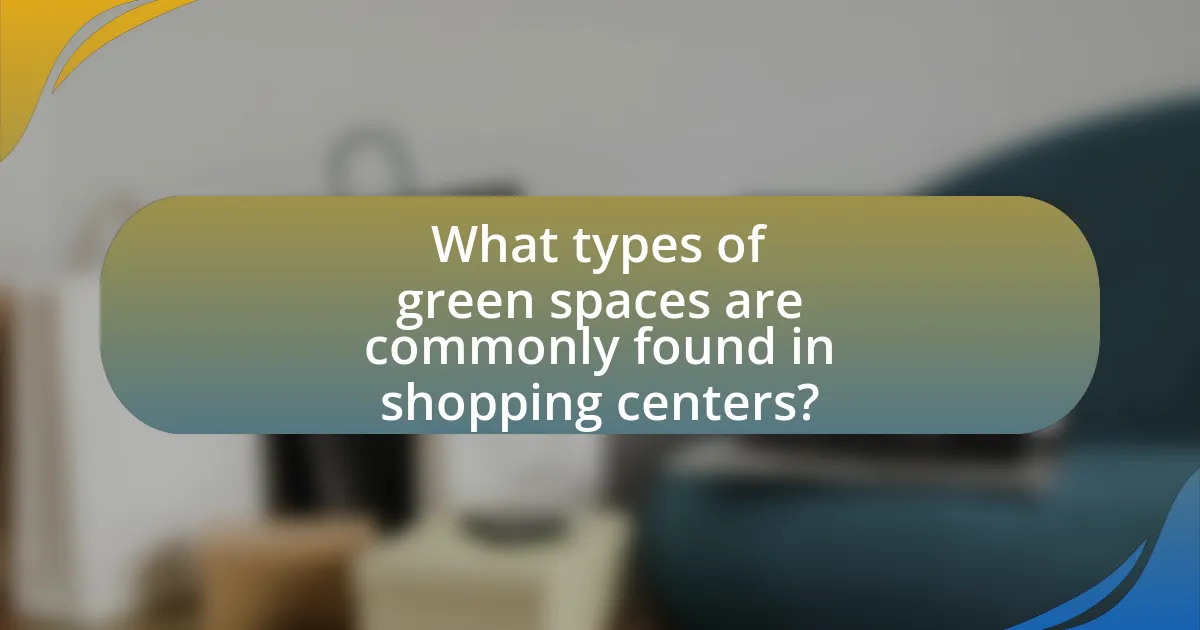
What types of green spaces are commonly found in shopping centers?
Shopping centers commonly feature several types of green spaces, including landscaped gardens, green roofs, planters, and outdoor seating areas with vegetation. Landscaped gardens provide aesthetic appeal and a relaxing environment for shoppers, while green roofs contribute to sustainability and energy efficiency. Planters filled with flowers and shrubs enhance the visual experience and improve air quality. Outdoor seating areas often incorporate trees and plants, creating inviting spaces for customers to rest and socialize. These green spaces not only enhance the shopping experience but also promote environmental benefits, such as biodiversity and urban cooling.
How do different types of green spaces serve shoppers?
Different types of green spaces serve shoppers by enhancing their shopping experience through relaxation, aesthetic appeal, and social interaction. Parks, gardens, and green rooftops provide a calming environment that reduces stress, making shoppers more likely to spend time and money. Research indicates that shopping centers with green spaces see a 20% increase in foot traffic, as these areas attract visitors seeking a pleasant atmosphere. Additionally, green spaces encourage social gatherings, fostering community engagement and increasing the likelihood of repeat visits.
What role do parks and gardens play in shopping centers?
Parks and gardens in shopping centers serve as essential green spaces that enhance the overall shopping experience. They provide a relaxing environment, encouraging visitors to spend more time at the center, which can lead to increased foot traffic and higher sales for retailers. Research indicates that shopping centers with green spaces can see a 10-20% increase in customer dwell time, as these areas offer a respite from the urban environment. Additionally, parks and gardens contribute to improved air quality and biodiversity, making shopping centers more appealing and sustainable.
How do green roofs and vertical gardens enhance shopping experiences?
Green roofs and vertical gardens enhance shopping experiences by improving aesthetic appeal and promoting environmental sustainability. These green features create visually pleasing environments that attract customers, leading to increased foot traffic and longer dwell times. Research indicates that shopping centers with green spaces can see a 10-20% increase in customer visits, as greenery is associated with relaxation and well-being. Additionally, green roofs and vertical gardens contribute to better air quality and temperature regulation, making shopping areas more comfortable. This combination of visual and environmental benefits ultimately enhances the overall shopping experience, encouraging consumer engagement and satisfaction.
What are the design considerations for integrating green spaces in shopping centers?
Design considerations for integrating green spaces in shopping centers include accessibility, aesthetics, environmental impact, and functionality. Accessibility ensures that green spaces are easily reachable for all visitors, promoting inclusivity. Aesthetics enhance the visual appeal of the shopping center, attracting customers and improving their overall experience. Environmental impact focuses on sustainability, such as using native plants to reduce water usage and support local biodiversity. Functionality involves creating spaces that can be used for events or relaxation, thereby increasing foot traffic and dwell time. Research indicates that shopping centers with green spaces can see a 10-20% increase in customer visits, demonstrating the positive effects of well-designed green areas on consumer behavior.
How can shopping centers balance green space with retail space?
Shopping centers can balance green space with retail space by integrating landscaped areas, such as parks and gardens, within the shopping complex. This approach not only enhances the aesthetic appeal but also improves customer experience and promotes environmental sustainability. For instance, a study by the University of Queensland found that incorporating green spaces can increase foot traffic by up to 20%, as shoppers are more likely to visit areas that offer a pleasant environment. Additionally, utilizing vertical gardens and green roofs allows for the maximization of retail space while still providing essential greenery, thereby creating a harmonious blend of commerce and nature.
What sustainable practices can be employed in the design of green spaces?
Sustainable practices in the design of green spaces include the use of native plants, rainwater harvesting, and permeable paving. Native plants require less water and maintenance, promoting biodiversity and reducing the need for chemical fertilizers and pesticides. Rainwater harvesting systems can capture and utilize rainwater for irrigation, decreasing reliance on municipal water supplies. Permeable paving allows for natural water infiltration, reducing runoff and promoting groundwater recharge. These practices contribute to environmental sustainability and enhance the ecological health of urban areas, aligning with the goals of creating effective green spaces in shopping centers.
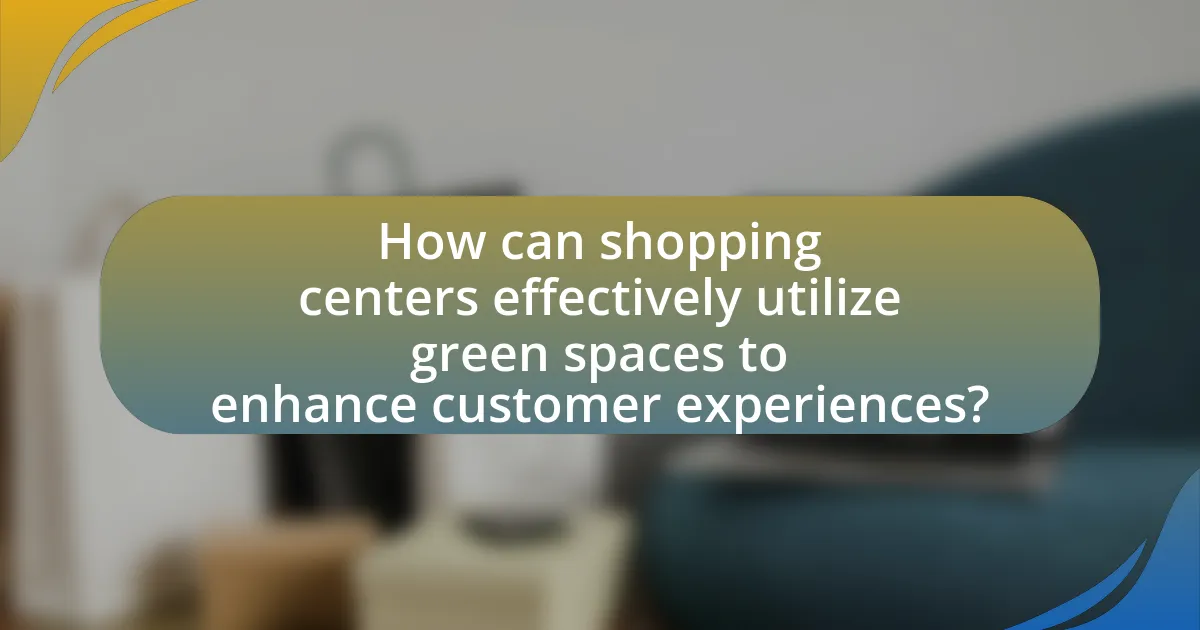
How can shopping centers effectively utilize green spaces to enhance customer experiences?
Shopping centers can effectively utilize green spaces by incorporating landscaped areas, seating, and recreational features that promote relaxation and social interaction among customers. Research indicates that green spaces can reduce stress and enhance mood, leading to longer visits and increased spending. For instance, a study published in the Journal of Environmental Psychology found that environments with greenery can improve customer satisfaction by 20% and encourage repeat visits. By strategically placing gardens, trees, and open areas, shopping centers can create inviting atmospheres that enhance the overall shopping experience.
What strategies can shopping centers implement to maximize the benefits of green spaces?
Shopping centers can maximize the benefits of green spaces by integrating diverse plant species, creating multifunctional areas, and incorporating sustainable practices. Diverse plant species enhance biodiversity, improve air quality, and provide aesthetic appeal, which can attract more visitors. Multifunctional areas, such as gardens or seating spaces, encourage social interaction and relaxation, increasing the time customers spend at the center. Sustainable practices, like using native plants and implementing rainwater harvesting, reduce maintenance costs and environmental impact, further enhancing the shopping experience. Research indicates that shopping centers with well-designed green spaces can see a 10-20% increase in foot traffic and customer satisfaction, demonstrating the tangible benefits of these strategies.
How can events and activities in green spaces attract more visitors?
Events and activities in green spaces can attract more visitors by creating engaging experiences that draw people to the area. For instance, hosting community events such as farmers’ markets, outdoor concerts, or fitness classes can enhance social interaction and provide entertainment, making the green space a desirable destination. Research indicates that well-organized events can increase foot traffic significantly; for example, a study by the National Recreation and Park Association found that parks with regular programming saw a 30% increase in visitor numbers. Additionally, activities that promote health and wellness, such as yoga sessions or nature walks, appeal to a broad audience, encouraging diverse groups to visit. By offering unique and varied experiences, green spaces can effectively attract more visitors and enhance the overall shopping center experience.
What role does maintenance play in the effectiveness of green spaces?
Maintenance is crucial for the effectiveness of green spaces as it directly impacts their aesthetic appeal, functionality, and ecological health. Regular upkeep, including landscaping, litter removal, and plant care, ensures that green spaces remain inviting and usable for visitors, which enhances their overall experience in shopping centers. Studies have shown that well-maintained green areas can increase foot traffic by up to 20%, as people are more likely to visit spaces that are clean and visually appealing. Additionally, proper maintenance supports biodiversity and helps sustain the environmental benefits these areas provide, such as air purification and temperature regulation, further contributing to a positive shopping center atmosphere.
What are some best practices for creating inviting green spaces in shopping centers?
Best practices for creating inviting green spaces in shopping centers include incorporating diverse plant species, providing comfortable seating, ensuring accessibility, and integrating water features. Diverse plant species enhance visual appeal and biodiversity, while comfortable seating encourages visitors to relax and enjoy the space. Accessibility is crucial, as it allows all shoppers, including those with disabilities, to engage with the green areas. Water features, such as fountains or ponds, create a calming atmosphere and attract wildlife, further enriching the shopping experience. Research indicates that well-designed green spaces can increase foot traffic and dwell time, ultimately boosting sales for retailers.
How can shopping centers engage the community in green space initiatives?
Shopping centers can engage the community in green space initiatives by organizing community events, such as tree planting days, gardening workshops, and eco-friendly fairs. These events foster community involvement and awareness about the importance of green spaces. For example, a study by the American Society of Landscape Architects found that community engagement in green projects increases local stewardship and enhances the overall appeal of shopping centers. Additionally, shopping centers can collaborate with local environmental organizations to create educational programs that inform the public about sustainability practices and the benefits of green spaces. This collaboration not only strengthens community ties but also promotes a shared responsibility for maintaining these areas.
What are the common challenges faced in maintaining green spaces in shopping centers?
Common challenges faced in maintaining green spaces in shopping centers include inadequate funding, limited space, and environmental factors. Inadequate funding often leads to insufficient resources for proper maintenance, resulting in overgrown plants and litter. Limited space restricts the types of greenery that can be planted and maintained, making it difficult to create diverse and appealing landscapes. Environmental factors, such as climate change and urban pollution, can negatively impact plant health and growth, further complicating maintenance efforts. These challenges highlight the complexities involved in sustaining green spaces that enhance shopping center experiences.

